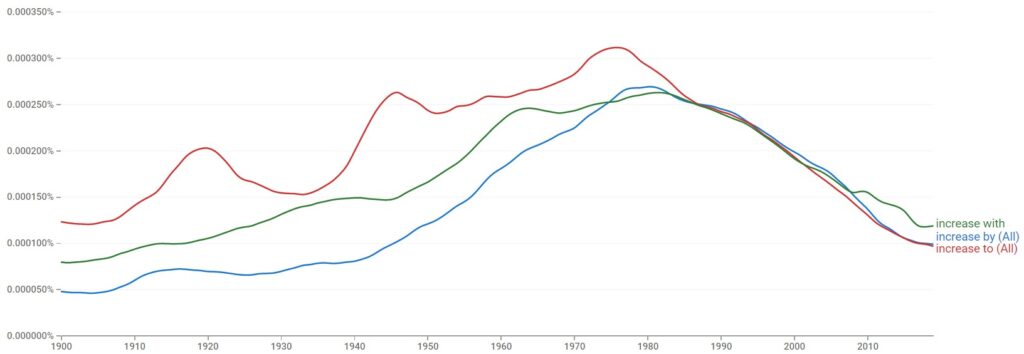Sometimes, the smallest things that seem negligible can have the most impact. That’s what it’s like with prepositions. A change in prepositions can change the meaning of your sentence completely, like how ‘increase by’ and ‘increase to’ mean two different things. Let’s see what their difference is!
Increase By or Increase To – Which Is Correct?
‘Increase by’ and ‘increase to’ are grammatically correct but they mean two different things, and are used in different contexts. We use ‘increase by’ when talking about the difference in the original and final amount, while we use ‘increase to’ when talking about the final amount only.

To understand the difference between the two phrases better, take a look at the example situation below.
Before, let’s say the price of the product was originally 3 dollars. After a few years, its current price is now 5 dollars. For this, we say:
- The price of the product increased by 2 dollars.
- The price of the product increased to 5 dollars.
In the sentences above, it is evident that we use ‘increased by’ in indicating how much was added to the original price, or by what amount did it increase. On the other hand, the second sentence that uses ‘increased to’ indicates the final amount or to what amount the price increased.
Given the differences in the meanings of the two phrases, generally, they are not interchangeable with one another, and neither are they similar or synonymous phrases. Even in mathematical or computational contexts, ‘by’ would indicate the difference between the initial and final amounts, while ‘to’ would indicate what the final amount would be.
Increase By
‘Increase by’ is a prepositional phrase that indicates the difference between an initial and a final amount of something. It indicates ‘by what amount did the amount increase to.’ It’s important to remember that using this phrase does not point out the final amount itself.
Take a look at the example below.
- What was originally 60 dollars last year increased by 45% this year.
In the sentence above, we get to understand that the original value of 60 dollars increased by 45%. This means that the difference or gap between the initial amount and the final amount is 45% of 60 which is 27. If you add 27 and 60, you get 87 which is your final amount. So, if originally, the price was 60 dollars, an increase by 45% this year would mean that this year’s price is 87 dollars.
Below are examples of using ‘increase by’ in a sentence.
- The price of the chair increased by 15% from last year’s price.
- The unemployment rate this year increased by 4% from last year.
- The limited capacity increased by three people instead of the original 15-people capacity.
- The gas price increased by 3 dollars.
- Stock market prices increased by 2% again today.
Increase To
‘Increase to’ is a prepositional phrase to indicate a new amount of something that has increased from its original amount. It indicates to what amount something has increased. A reminder that using ‘increase to’ expresses already the final amount, and we do not add the amount anymore to the initial amount.
Take a look at the example below.
- The price of bottled water increased to 3 dollars when it used to be just $1.50.
In the sentence above, ‘increased to’ indicates that the final amount or the price of bottled water now is 3 dollars, when it used to be just $1.50. The price increased by $1.50, so its final amount or the amount it increased to is $3.00.
Below are more examples of using ‘increased to’ in a sentence.
- Why did my account balance increase to 600 dollars?
- Our sales this month increased to 47%.
- The literacy rate in our country increased to 89%.
- The price of the chair increased to 300 dollars.
- What did you increase the price of your products to?
Increase With
‘Increase with’ is a prepositional phrase that expresses by what or through what an amount increased. For example, if we say ‘skills increase with practice,’ we mean that our skill levels or amount of skill increase through practicing or by practicing.
Below are examples of using ‘increase with’ in a sentence.Which Is Used the Most?
- My skills increased with lots of practice.
- The prices of the products increased with the global inflation at hand.
- Our sales increased with our improved promotions.
- Their teamwork increased with their frequent bonding sessions.
- The global stock market increased with the continuous rise of businesses.
According to the Google Ngram Viewer, a lot has changed in the trends of using the phrases over the years. But at the moment, ‘increase with’ is used most often, followed by ‘increase by’ and ‘increase to,’ respectively. However, the three are generally close with each other in trends.

Final Thoughts
‘Increase by’ and ‘increase to’ are both grammatically correct but are used in different contexts. ‘Increase by’ is used to indicate a difference between the initial amount and the final amount. On the other hand, ‘increase to’ is used to indicate what the final amount is.

Martin holds a Master’s degree in Finance and International Business. He has six years of experience in professional communication with clients, executives, and colleagues. Furthermore, he has teaching experience from Aarhus University. Martin has been featured as an expert in communication and teaching on Forbes and Shopify. Read more about Martin here.
